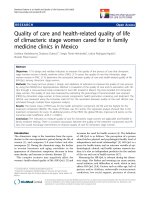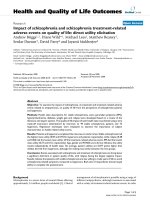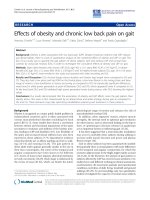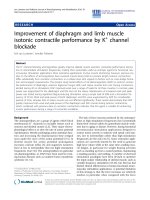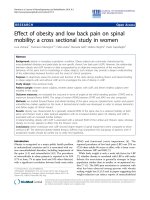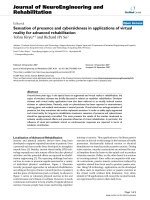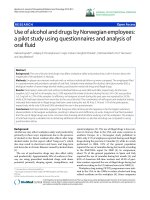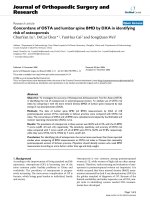Báo cáo hóa học: "Risk of septic knee following retrograde intramedullary nailing of open and closed femur fractures" pptx
Bạn đang xem bản rút gọn của tài liệu. Xem và tải ngay bản đầy đủ của tài liệu tại đây (135.27 KB, 9 trang )
This Provisional PDF corresponds to the article as it appeared upon acceptance. Fully formatted
PDF and full text (HTML) versions will be made available soon.
Risk of septic knee following retrograde intramedullary nailing of open and
closed femur fractures
Journal of Orthopaedic Surgery and Research 2012, 7:7 doi:10.1186/1749-799X-7-7
Jason J Halvorson ()
Marc Barnett ()
Ben Jackson ()
John P Birkedal ()
ISSN 1749-799X
Article type Research article
Submission date 2 June 2011
Acceptance date 17 February 2012
Publication date 17 February 2012
Article URL />This peer-reviewed article was published immediately upon acceptance. It can be downloaded,
printed and distributed freely for any purposes (see copyright notice below).
Articles in Journal of Orthopaedic Surgery and Research are listed in PubMed and archived at
PubMed Central.
For information about publishing your research in Journal of Orthopaedic Surgery and Research or
any BioMed Central journal, go to
/>For information about other BioMed Central publications go to
/>Journal of Orthopaedic Surgery
and Research
© 2012 Halvorson et al. ; licensee BioMed Central Ltd.
This is an open access article distributed under the terms of the Creative Commons Attribution License ( />which permits unrestricted use, distribution, and reproduction in any medium, provided the original work is properly cited.
Risk of septic knee following retrograde
intramedullary nailing of open and closed
femur fractures
ArticleCategory :
Research Article
ArticleHistory :
Received: 2-June-2011; Accepted: 3-Feb-2012
ArticleCopyright
:
© 2012 Halvorson et al; licensee BioMed Central Ltd.
This is an Open Access article distributed under the terms of the
Creative Commons Attribution License
( which permits
unrestricted use, distribution, and reproduction in any medium,
provided the original work is properly cited.
Jason J Halvorson,
Aff1
Corresponding Affiliation: Aff1
Phone: +1-336-5293485
Fax: +1-336-7166368
Email:
Marc Barnett,
Aff2
Email:
Ben Jackson,
Aff3
Email:
John P Birkedal,
Aff1
Email:
Aff1
Department of Orthopaedic Surgery, Wake Forest University Baptist
Medical Center, Medical Center Blvd, Winston-Salem, NC 27103,
USA
Aff2
Asheville Orthopaedic Associates, 11 Victoria Road, Asheville, NC
28801, USA
Aff3
Department of Orthopaedic Surgery, 1001 Blythe Blvd. Medical
Center Plaza Charlotte, Charlotte, NC 28203, USA
Abstract
Background
One potential complication of retrograde femoral nailing in the treatment of femur fractures
is the risk of septic knee. This risk theoretically increases in open fractures as a contaminated
fracture site has the potential to seed the instrumentation being passed in and out of the sterile
intraarticular starting point. There are few studies examining this potential complication in a
relatively commonly practiced technique.
Methods
All patients who received a retrograde femoral nail for femur fracture between September
1996 and November 2006 at a Level 1 trauma center were retrospectively reviewed. This
yielded 143 closed fractures, 38 open fractures and 4 closed fractures with an ipsilateral
traumatic knee arthrotomy. Patient follow-up records were reviewed for documentation of
septic knee via operative notes, wound culture or knee aspirate data, or the administration of
antibiotics for suspected septic knee.
Results
No evidence of septic knee was found in the 185 fractures examined in the dataset. Utilizing
the Wilson confidence interval, the rate of septic knee based on our population was no greater
than 2%, with that of the open fracture group alone being 9%.
Conclusions
Based on these results and review of the literature, the risk of septic knee in retrograde
femoral nailing of both open and closed femoral shaft fractures appears low but potentially
not insignificant.
Funding
There was no outside source of funding from either industry or other organization for this
study.
Introduction
Fractures of the femur are a common injury encountered by orthopaedic surgeons.
Intramedullary nailing has become the gold standard for treatment of shaft fractures and has
been routinely employed since the 1970’s.[1-4] Traditionally, femoral nails have been
inserted in an antegrade fashion with a start point at the piriformis fossa or the greater
trochanter. Retrograde nails utilizing an intra-articular insertion point at the knee with a
retrograde trajectory for femoral nailing has been described [5] and has gained great
popularity in recent years. As the indications for retrograde nailing continue to evolve [6-15],
several publications have reported comparable outcomes following retrograde or antegrade
femoral nailing. The retrograde technique confers potentially unique complications as
compared with the antegrade technique. One area of concern involves infection of the knee
joint.[8,9,16] There are many proposed mechanisms for development of a septic knee with
the retrograde femoral nail technique. The repeated passage of instrumentation (reamers)
through the intraarticular start point at the knee may potentially contaminate the sterile joint
space. Similarly, in open fractures, passing reamers through the “contaminated” open fracture
and out through the knee joint is thought to potentially enhance the risk of septic arthritis.
After closure, the nail provides a hypothetical conduit for bacteria from the fracture site to
enter the knee joint. One author has specifically stated that “severe grade III open fractures
probably should not be treated with a retrograde nail,” [9] based on the occurrence of a late
septic knee in a patient treated with this technique.
The specific aim of the current study was to review the clinical outcomes of all retrograde
femoral nails performed at a Level I trauma center over a 10 year span with a focus on the
incidence of septic knee in patients with either open or closed fractures. Our hypothesis was
that patients undergoing retrograde femoral nailing are not at a significantly increased risk of
knee sepsis following treatment for open or closed femur fractures.
Methods
After internal Institutional Review Board approval, and in compliance with the Helsinki
Declaration, a list of all patients undergoing operative treatment for femoral shaft or
supracondylar femur fracture between September 1996 and November 2006 at a Level 1
trauma center was generated from CPT codes. This generated a list of 1,163 fractures for
potential analysis. Operative notes from these patients were reviewed to identify all patients
with a retrograde nail placed via the standard described technique using an intraarticular
starting point. There were no original exclusion criteria for those included into the database.
A total of 309 patients with 352 fractures were originally identified as meeting inclusion
criteria.
Patients were then divided into two groups: those with greater and those with fewer than six
months of orthopaedic follow-up. Attempts were made to contact patients with less than 6
months orthopaedic follow-up via phone using the hospital’s database of patient demographic
information, including phone numbers and listed emergency contacts. If the hospital
demographic information was incorrect, a commercial website, peoplefinders.com™, was
accessed for additional patient contact information. Patients who were successfully contacted
were asked to complete a phone questionnaire about their post-operative course, including the
need for knee aspiration, antibiotics, cultures, or open/closed procedures for
irrigation/debridement of the knee. Contact was successfully made with an additional 14
patients (14 fractures); 11 within the closed fracture group and 3 within the open fracture
group. Most patients who could not be contacted had an incorrect or disconnected phone
number.
Excluding those patients without documented orthopaedic follow-up of greater than six
months, 245 fractures out of the original 352 fractures remained. Open and closed fractures
were analyzed separately to determine the risk of septic knee within each sub-population of
patients who received a retrograde femoral nail. For statistical analysis, all patients with
bilateral fractures were excluded as to prevent introduction of bias. This removed 30 total
patients from analysis, leaving 185 patients for final analysis (143 closed fractures, 42 open
fractures). There was a sub-population identified within the open fracture group which
sustained a traumatic knee arthrotomy with associated closed femur fracture. Four patients fit
this criterion and were excluded, bringing the number of patients with open femur fracture to
38. Three fractures were pathologic in nature. Eleven retrograde nails were used for peri-
prosthetic knee or hip fractures. One hundred seventeen patients were considered poly-
trauma.
A retrospective chart review of patients with the remaining 245 fractures was performed to
further characterize open vs closed injury, the grade of open injury when applicable, and
complications. All open fractures were treated with emergency department bedside irrigation
and debridement and antibiotics. There is no standardized protocol for antibiotic type and for
how long those antibiotics are continued post-operatively for open fractures within our
institution as this is instructor dependent. Therefore, the role of type, duration, and affect of
antibiotic was impossible to examine, document, and control. They were then taken to the
operating room as soon as possible pending trauma clearance and operating room availability.
The only reason patients with open fractures were not taken to the operating room in an
urgent or emergent fashion was secondary to life threatening traumatic or neurosurgical
injuries which precluded orthopaedic intervention. In these cases, antibiotics were continued
and the patient was taken to the operating room for formal irrigation and debridement when
medically stable. Post-operative medical records were reviewed for documentation of
infections, knee wounds, knee cultures/aspirates, and signs or symptoms of knee infection. A
definition of septic knee was pre-defined as the identification of positive cultures from a knee
aspirate, intraoperative irrigation and debridement, or any clinical signs and symptoms of
deep knee infection (as opposed to superficial wound infection).
Time to union, rates of non-union, diagnosis of osteomyelitis, and other complications were
not tabulated in our analysis as they were out of the scope of our hypothesis with regard to
the documented occurrence of septic knee.
A confidence interval was chosen for statistical analysis of the data. However, given the low
occurrence rate of septic knee within our population, the author’s utilized Wilson’s
Confidence Interval for data analysis in hopes to more accurately capture the true incidence
of septic knee.
Demographic data from the fracture database is enclosed in Table 1. Overall follow-up rate of
patients with greater than 6 month documented orthopaedic evaluation was 70%. Open
injuries were classified as defined by the Gustillo-Anderson classification system.[17] Of the
open injuries, 7 were Gustillo-Anderson type I, 17 were type II, 7 were type III, and 7 were
simply reported as gunshot wounds (Table 2).
Table 1 Demographic Data
Combined
Open/Closed
Fractures
Closed
Fractures Open Fractures
Arthrotomy
with Closed
Femur Fracture
Total Patients with at
least 6 month follow-up
185 143 38 4
Average age yrs (range)
38 (14-91) 40 (14-91) 33 (17-69) 28 (17-49)
Number Males/Females
94/91 84/107 30/8 0\4
Left/Right Knee 105/80 63/80 23/15 3\1
Average follow-up,
months (range)
29 (6-116) 28 (6-114) 30 (6-116) 37 (6-116)
Table 2 Break-down by Gustillo-Anderson Classification of Open Fractures
Fracture Grade (Gustillo-
Anderson)
Number
GI 7
GII 17
GIII 7
Gunshot 7
Traumatic Arthrotomy with
Ipsilateral Femur Fracture
4
Results
Nine patients were noted to have documented infections requiring return trip to the operating
room: four within the closed fracture cohort and five within the open fracture cohort (overall
rate 3%). Five of the nine patients were documented to have an infected nonunion, three of
which were within the open fracture cohort. Two patients were found to have osteomyelitis
with fracture union (one in each group). Two patients were found to have wound infections
requiring irrigation and debridement (one in each group) without evidence of deep infection.
There was no documentation within the medical records of an occurrence of septic knee;
specifically, there were no reports of positive knee aspirate cultures, surgical procedures for
knee sepsis, exchange nailing for suspected knee sepsis, or antibiotics (intravenous or oral)
prescribed for suspected septic knee infection. The calculated Wilson confidence interval for
septic knee after retrograde femoral nailing for each sample size and population can be found
in Table 3. Using our sample size of 185 patients, the Wilson confidence interval of
pyarthrosis following retrograde femoral nailing (either open or closed fracture) was found to
be 0% - 2% using a 95% confidence interval. The Wilson confidence interval for septic knee
following closed retrograde nailing using our sample size of 143 fractures was 0% - 2.6%
with a 95% confidence interval. When looking at the open fracture group alone, the Wilson
confidence interval for septic knee following a retrograde nail was 0% - 9% with a 95%
confidence interval. (Table 3)
Table 3 Incidence of septic knee utilizing the Wilson Confidence Interval (95% Confidence
Interval) for all patients treated with retrograde intramedullary nail and retrograde nail
treatment separated into those patients with open and closed femur fractures
Patients Wilson Confidence Interval For Septic
Knee
Total 185 2%
Open 38 9%
Closed 143 2.60%
Discussion
In the review of our data, there was no record of a septic knee within the medical record
documentation at our Level I trauma center in a 10 year span when retrograde femoral nailing
was used for treatment of both open and closed femoral fractures. We were able to follow
70% of patients greater than 6 months who received a retrograde femoral nail within the 10
year span. Utilizing the Wilson confidence interval, the overall rate of septic knee when using
the retrograde femoral nail technique for femur fractures at our institution would be expected
to be no greater than 2% with a 95% confidence interval. Isolating the open femur fracture
group, the Wilson confidence interval for finding a pyarthrosis following retrograde nail rises
to 9% with a 95% confidence interval which is not insignificant given the potential
devastating consequences of this complication. The small sample size limits definitive
conclusions regarding the safety of retrograde nails for open femur fractures. While, in
practice, we routinely use retrograde femoral nails in association with open femur fractures,
our data at least suggest the possibility that knee pyarthrosis is a concern following this
technique.
In addition, four patients sustained a traumatic arthrotomy at the time of injury associated
with ipsilateral closed femur fracture. An advantage of a retrograde approach in this condition
is that the surgical exposure in these cases is essentially already present allowing the
placement of the retrograde nail via the traumatic arthrotomy. The concern in utilizing a
retrograde nail in this situation is similar to the situation of an open fracture in that a
potentially contaminated wound may contaminate the inserted hardware. The low number of
patients in this group precludes a definitive conclusion about the risk of septic knee when a
traumatic arthrotomy is present. However, none of these patients had report of a septic knee.
The rare rate of septic knee within our cohort is consistent with the current literature. In the
one systematic review of retrograde femoral nails which included 914 patients in 24 journal
articles, only one septic knee was identified for an overall incidence of 0.18%.[10] No
breakdown of statistics was performed comparing open vs closed fractures and rates of
infection. Other reported rates of septic knee following retrograde nailing of femur fractures
is low.[9,16] Finally, a recent analysis by O’Toole et al. demonstrated overall rate of septic
knee in open femur fractures at 1.1% in 90 patients.[18] While their reported rate of septic
knee is low, they admit to being underpowered despite their multi-center study,
demonstrating the magnitude of patients necessary and difficulty in soundly answering this
question.
Weaknesses to this study include its retrospective nature and the bias this inherently creates.
Also, low patient numbers preclude definitive recommendations as to the safety regarding the
occurrence of septic knee following this retrograde nailing for femur fractures. In addition,
the self-imposed use not including patients with less than 6 month follow-up excluded a
number of patients. Patients with less than six month follow-up were arbitrarily excluded for
their relatively short-term follow-up and potential lack of information regarding
complications of the procedure. Including these patients would potentially offer false
negatives into the final statistical analysis. The majority of patients with less than 6 month
follow-up were evaluated at clinic visits between 1–6 months. Review of these 81 medical
records provided no evidence of septic knee by the definitions used above (data not
included).
With use of the Wilson confidence interval, we were able to demonstrate a low rate of septic
knee with global use of the retrograde nailing technique when used for femur fractures,
regardless of being open or closed fractures. However, the risk of septic knee in a closed
fracture and sterile operating room environment with sterile tools confers little increased risk
of septic knee. The concern comes with a contaminated open fracture site with reamers
passing in and out of a ‘sterile’ intra-articular space. The trend from our data certainly
appears to suggest a low incidence of septic knee when using retrograde nails for both open
and closed fractures. However, we cannot definitively state with absolute statistical
significance that the risk of septic knee for either open or closed femur fracture treated via a
retrograde technique is negligible. While this study should offer the practicing orthopaedic
surgeon confidence that the overall risk of septic knee with this technique for treating either
open or closed femur fractures is low, further study with larger numbers is necessary in order
to definitively confirm the exact incidence and rate of this complication.
Competing interest
No competing interests to disclose.
Authors’ contribution
All authors were involved with manuscript idea, preparation, data collection/analysis,
statistical analysis, and writing/revision of manuscript. All authors have approved the above
manuscript.
References
1. Brick EM: The Intramedullary Nailing of Fractures by G. Kuntscher. Translation of
article in Archiv fur Klinische Chirurgie, 200:443, 1940. Clin Orthop Relat Res 1968,
60:5–12.
2. Kempf I, Grosse A, Beck G: Closed locked intramedullary nailing. Its application to
comminuted fractures of the femur. J Bone Joint Surg Am 1985, 67(5):709–720.
3. Winquist RA, Hansen ST Jr, Clawson DK: Closed intramedullary nailing of femoral
fractures. a report of five hundred and twenty cases. J Bone Joint Surg Am 1984,
66(4):529–539.
4. Wolinsky PR, McCarty E, Shyr Y, et al: Reamed intramedullary nailing of the femur:
551 cases. J Trauma 1999, 46(3):392–399.
5. Herscovici D Jr, Whiteman KW: Retrograde nailing of the femur using an
intercondylar approach. Clin Orthop Relat Res 1996, 332:98–104.
6. Handolin L, Pajarinen J, Lindahl J, et al: Retrograde intramedullary nailing in distal
femoral fractures–results in a series of 46 consecutive operations. Injury 2004,
35(5):517–522.
7. Holmenschlager F, Piatek S, Halm J, et al: Retrograde intramedullary nailing of
femoral shaft fractures. a prospective study. Unfallchirurg 2002, 105(12):1100–1108.
8. Moed BR, Watson JT: Retrograde nailing of the femoral shaft. J Am Acad Orthop Surg
1999, 7(4):209–216.
9. Ostrum RF, DiCicco J, Lakatos R, et al: Retrograde intramedullary nailing of femoral
diaphyseal fractures. J Orthop Trauma 1998, 12(7):464–468.
10. Papadokostakis G, Papakostidis C, Dimitriou R, et al: The role and efficacy of
retrograding nailing for the treatment of diaphyseal and distal femoral fractures: a
systematic review of the literature. Injury 2005, 36(7):813–822.
11. Patterson BM, Routt ML Jr, Benirschke SK, et al: Retrograde nailing of femoral shaft
fractures. J Trauma 1995, 38:38–43.
12. Ricci WM, Bellabarba C, Evanoff B, et al: Retrograde versus antegrade nailing of
femoral shaft fractures. J Orthop Trauma 2001, 15(3):161–169.
13. Sanders R, Koval KJ, DiPasquale T, et al: Retrograde reamed femoral nailing. J
Orthop Trauma 1993, 7(4):293–302.
14. Swiontkowski MF, Hansen ST Jr, Kellam J: Ipsilateral fractures of the femoral neck
and shaft. a treatment protocol. J Bone Joint Surg Am 1984, 66(2):260–268.
15. Tornetta P 3rd, Tiburzi D: Antegrade or retrograde reamed femoral nailing. a
prospective, randomised trial. J Bone Joint Surg Br 2000, 82(5):652–654.
16. Lucas SE, Seligson D, Henry SL: Intramedullary supracondylar nailing of femoral
fractures. a preliminary report of the GSH supracondylar nail. Clin Orthop Relat Res
1993, 296:200–206.
17. Gustilo RB, Anderson JT: Prevention of infection in the treatment of one thousand
and twenty-five open fractures of long bones: retrospective and prospective analyses. J
Bone Joint Surg Am 1976, 58(4):453–458.
18. O’Toole RV, Riche K, Cannada LK, Hennessy M, Sciadini MF, Shi LL, Woodford M,
Harris MB: Analysis of postoperative knee sepsis after retrograde nail insertion of open
femoral shaft fractures. J Orthop Trauma 2010, 24(11):677–682.
